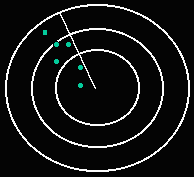Topics
Quiz
Examples
I promised one but I have three examples for you.
-
The Classic Radar Operator Example
-
The Shower/Phone Example
-
The Eye Exam
The Classic Radar Operator Example
The signal detection theory evolved out of developments of
communications early in this century. One of the situations where the
application of this theory to human perception was first noted was in the use of
early radar in WWII. This radar was not the nice computer processed fancy
color image we are used to on the Weather Channel. Instead, it was a
circular disc with a line sweeping around from the center representing the
current direction of the radar antenna. Behind this line were briefly
illuminated dots. See the figure below for an attempt at a representation
of this situation.

These green dots trailing trailing the sweeping are are visible only briefly and can be caused by many different object in the environment or even just the weather itself. The weather operator in WWII, often alone on the southern coast of Great Britain, would have to decide if these dots were enemy aircraft or not.
So we have noise: stray dots on the screen. We have a signal, dots caused by the aircraft of the enemy. We have an ambiguous situation. It was often hard to tell the different between the two sources for the dots on your screen. So the operator has to make a decision about what to do when he sees dots. Are they noise or enemy aircraft? If the operator thinks the dots are aircraft he is to alert the nearest air force base to launch planes to intercept the enemy. The table below puts this situation into a signal detection framework.
| Signal: Are there actually enemy aircraft indicated on the radar screen? | |||
| Yes | No | ||
| Decision: are they enemy Aircraft? | Yes | Hit | False Alarm |
| No | Miss | Correct Rejection | |
With this example it is easier to see some of the effects of different decisions. In this example if the operator makes a:
-
hit. The enemy are engaged perhaps before they even reach land and might be turned away before they can even attack their target.
-
miss. The enemy attach their target and perhaps catch our planes on the ground which makes them very easy to destroy.
-
false alarm. Our aircraft take off to no effect. This wastes fuel which was in short supply at this time. In addition, you can fatigue both the pilots and their aircraft making them less ready for the next attack.
-
correct rejection. The crews and planes get needed rest and fuel is not wasted.
As you can see, the correct decision is very important. Errors have negative consequences or costs associated with them.